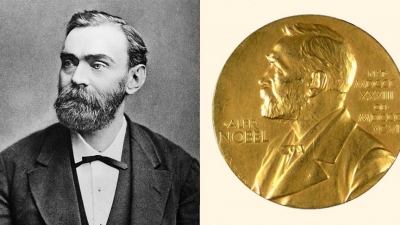
Alfred Nobel was born in Sweden on October 21, 1833. He was interested in literature, but his family steered him towards chemical engineering, to follow his father’s example. Nobel’s father Immanuel was an engineer who experimented with different explosives.
An explosive discovery
Once while mixing different additives to nitroglycerine, Nobel discovered that adding fine sand – silica – turns the liquid into paste, which made it safer and easier to handle. He moulded the paste into rods, which could be inserted into holes for controlled explosions. Nobel patented his discovery as dynamite. Always eager to experiment and innovate, he acquired as many as 355 patents during his lifetime; most of them dealt with manufacturing arms and helped him earn a fortune.
A change of heart
An unusual incident that took place in 1888 forced Nobel to re-evaluate his life. A French newspaper mistakenly published an obituary on him (instead of his brother Ludvig who had died due to a heart attack.) Titled “The Merchant of Death,” it criticised Nobel for the sale of arms. The error was later corrected, but it continued to prick his conscience. On November 27, 1895, Nobel signed his last will and testament, stipulating that 94% of his assets should be used to establish a series of five awards to felicitate excellence in the fields of Physics, Chemistry, Medicine and Physiology, Literature and Peace. Nobel died in 1896 and the Nobel Prizes were handed out for the very first time in 1901.
ON THE 2020 HONOUR ROLL
- Chemistry: Jointly awarded to Emmanuelle Charpentier and Jennifer A. Doudna “for the development of a method for genome editing.”
- Physics: One half to Roger Penrose for the discovery that black hole formation is a robust prediction of the general theory of relativity” and the other half jointly to Reinhard Genzel and Andrea Ghez “for the discovery of a supermassive compact object at the centre of our galaxy.”
- Physiology and Medicine: Shared between Harvey J. Alter, Michael Houghton and Charles M. Rice “for the discovery of Hepatitis C virus.”
- Literature: U.S. poet Louise Glück for “her unmistakable poetic voice that with austere beauty makes individual existence universal.”
- Peace: The UN World Food Programme (WFP).
DID YOU KNOW?
- Have you ever wondered why the Nobel Prize winners are called laureates? The word Laureate’ refers to the laurel wreath’ which is a symbol of victory and honour in Greek mythology.
- Marie Curie is the only person who was awarded the Nobel in two different scientific categories – Physics and Chemistry.
- Malala Yousafzai is the youngest to win the Nobel. She was only 17 when she won the Nobel Peace Prize.
- John B. Goodenough is the oldest person to win the Nobel Prize for Chemistry. He won in 2019 at the age of 97.
Picture Credit : Google

